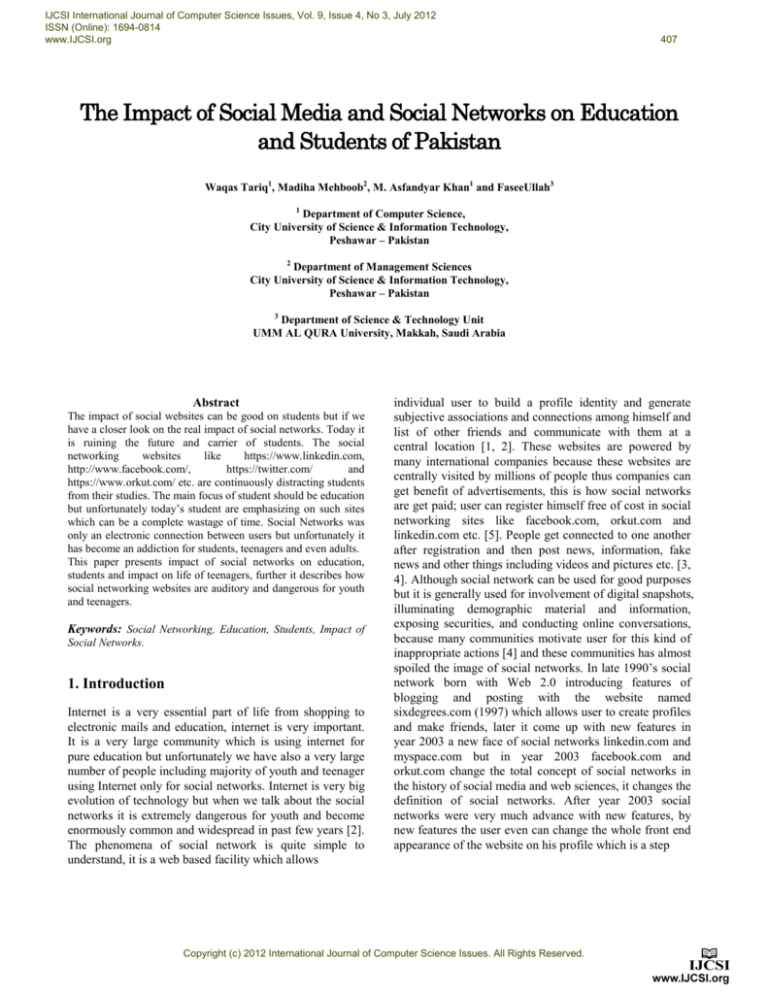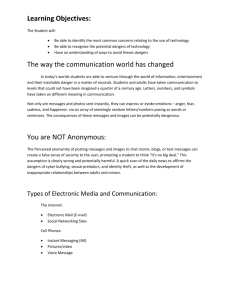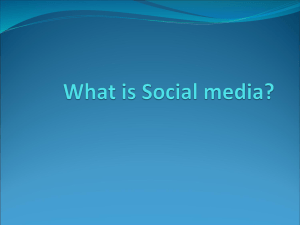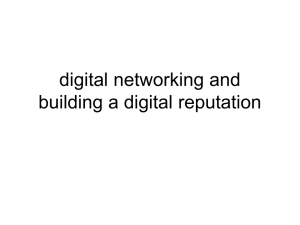
IJCSI International Journal of Computer Science Issues, Vol. 9, Issue 4, No 3, July 2012
ISSN (Online): 1694-0814
www.IJCSI.org
407
The Impact of Social Media and Social Networks on Education
and Students of Pakistan
Waqas Tariq1, Madiha Mehboob2, M. Asfandyar Khan1 and FaseeUllah3
1
Department of Computer Science,
City University of Science & Information Technology,
Peshawar – Pakistan
2
Department of Management Sciences
City University of Science & Information Technology,
Peshawar – Pakistan
3
Department of Science & Technology Unit
UMM AL QURA University, Makkah, Saudi Arabia
Abstract
The impact of social websites can be good on students but if we
have a closer look on the real impact of social networks. Today it
is ruining the future and carrier of students. The social
networking
websites
like
https://www.linkedin.com,
http://www.facebook.com/,
https://twitter.com/
and
https://www.orkut.com/ etc. are continuously distracting students
from their studies. The main focus of student should be education
but unfortunately today’s student are emphasizing on such sites
which can be a complete wastage of time. Social Networks was
only an electronic connection between users but unfortunately it
has become an addiction for students, teenagers and even adults.
This paper presents impact of social networks on education,
students and impact on life of teenagers, further it describes how
social networking websites are auditory and dangerous for youth
and teenagers.
Keywords: Social Networking, Education, Students, Impact of
Social Networks.
1. Introduction
Internet is a very essential part of life from shopping to
electronic mails and education, internet is very important.
It is a very large community which is using internet for
pure education but unfortunately we have also a very large
number of people including majority of youth and teenager
using Internet only for social networks. Internet is very big
evolution of technology but when we talk about the social
networks it is extremely dangerous for youth and become
enormously common and widespread in past few years [2].
The phenomena of social network is quite simple to
understand, it is a web based facility which allows
individual user to build a profile identity and generate
subjective associations and connections among himself and
list of other friends and communicate with them at a
central location [1, 2]. These websites are powered by
many international companies because these websites are
centrally visited by millions of people thus companies can
get benefit of advertisements, this is how social networks
are get paid; user can register himself free of cost in social
networking sites like facebook.com, orkut.com and
linkedin.com etc. [5]. People get connected to one another
after registration and then post news, information, fake
news and other things including videos and pictures etc. [3,
4]. Although social network can be used for good purposes
but it is generally used for involvement of digital snapshots,
illuminating demographic material and information,
exposing securities, and conducting online conversations,
because many communities motivate user for this kind of
inappropriate actions [4] and these communities has almost
spoiled the image of social networks. In late 1990’s social
network born with Web 2.0 introducing features of
blogging and posting with the website named
sixdegrees.com (1997) which allows user to create profiles
and make friends, later it come up with new features in
year 2003 a new face of social networks linkedin.com and
myspace.com but in year 2003 facebook.com and
orkut.com change the total concept of social networks in
the history of social media and web sciences, it changes the
definition of social networks. After year 2003 social
networks were very much advance with new features, by
new features the user even can change the whole front end
appearance of the website on his profile which is a step
Copyright (c) 2012 International Journal of Computer Science Issues. All Rights Reserved.
IJCSI International Journal of Computer Science Issues, Vol. 9, Issue 4, No 3, July 2012
ISSN (Online): 1694-0814
www.IJCSI.org
towards evolution. Figure 1.1(a) shows the evolution of
social networks from 1999 to 2011. It is briefly dissipated
the use of social networks from the very first social
network website sixdegrees.com to the doom of decade,
facebook.com as shown figure 1.1(a) and 1.1(b), it has
shown the year of websites popularity and probability of
the usage in the given graph for every particular website in
figure 1.1(b) it has been plotted the history of social
networks from 1999 to 2011 that how social networks
come up with a very big ratio of usage today.
408
time but according to survey one user is facilitating him by
fake identities on same time as shown in figure 1.2.
Fig. 1.2 Graph Representations Of Underage User And Fake Identities
Fig. 1.1(a)
Figure 1.2 shows the average of fake identities and
underage users. According to the survey a very large
number of fake identities exist in social networks, these
fake identities perform many kind of violations on social
Networks in which they register themselves as a fake
identity on name of someone else and upload of
inappropriate material (Porn or adult) with fake identity it
is very much common act of violation. Those users who
share their personal information online are badly
victimized by fake users [7]. It has also recorded a very
large number of underage user using social networks which
is almost double of adults (18+) users, social networks are
used by three categories of people one of which is
teenagers second one is young adults and the third one is
adults (18+). According to another survey it has been
recorded the ratios of teenage users by categorizing the
users in three categories one of which is teenagers (12 - 17)
second one is young adults (18 – 21) and the third one is
adults (22+) as shown in figure 1.3.
Fig. 1.1(b)
When talking about law and jurisdiction unfortunately we
don’t have any law for Social networks in Pakistan, as it is
international law that user must be minimum 18 years old
or more to register yourself in any social network website.
We don’t have any authority or third party to check the
user if user is underage or acceptable age. After a survey it
has been analyzed that one of very large number of
underage users, using social network websites beside this,
one user can have one ID (Identity) or profile at the same
Fig. 1.3 Ratio of teenage, young adults and adults users
As shown in figure 1.3 it has shown the ratios of teenage
users with the average of using social networks, not using
social networks and wishes to use social networks. The
average of users those who use social networks are those
users which use social networks regularly on daily bases,
while those users who wish to use social networks are
those who don’t have internet or parental permission or
any other problem to use social networks but they wish to
use social networks. It has been recorded another
community of people those who don’t use social networks
Copyright (c) 2012 International Journal of Computer Science Issues. All Rights Reserved.
IJCSI International Journal of Computer Science Issues, Vol. 9, Issue 4, No 3, July 2012
ISSN (Online): 1694-0814
www.IJCSI.org
in fact they don’t want to use social networks because they
dislike social networks.
2. IMPACT OF SOCIAL NETWORKS ON
EDUCATION
Education is very essential part of an individual’s life
for every teenager education is more important than
anything. Today teenager shows very much interest for
using social networks but unfortunately Social Networks
affect education badly [3]. Previous research has
calculated that more than 90% of college students use
social networks [9, 10]. Technology has shown a fast
development by producing small communication devices
but these small communication devices can be used for
accessing social networks any time anywhere, these
devices include pocket computers, laptops, iPads and even
simple mobile phones (which support internet) etc.
Technology is step towards betterment, no doubt but any
technology which can provide ease of social networks can
be dangerous for social network addicts. Providing
ubiquitous facility of social networks is a straight invitation
of addiction to any teenager and even an adult, as
academic satisfaction is not enough for those students who
suffers from social isolation [11]. Social Networks grab the
total attention and concentration of the students and diverts
them towards non educational, unethical and inappropriate
actions such as useless chatting, time killing by random
searching and not doing their jobs. As social network has
introduce many attractive tasks like gamming,
advertisements etc. so that people can never get enough of
these things. The social network addict becomes a useless
node for parents, friends and other associated people. They
cannot succeed because they have no sense of upcoming
future and competitions in their careers.
Social networks use support of difference implicit
applications by virtue of which it grabs the attention of
students and increase the number of users. The
applications include games, advertisements, and other
online activities like online live television etc. User can use
these applications free, so that’s why gaming freaks and
addicts use to play these games without any installation
and any other formality any time anywhere, these free of
cost pleasure destruct students from their education, and
they do not concentrate on their education. As all of the
applications are based on 2D screen play so by watching
long time same screen could cause high blood pressure and
anxiety which could be dangerous for education and health.
According to survey students do not take their meals on
time and do not sleep on time which causes a very non
serious attitude with education. All they need after
addiction is use of social networks. Social network connect
them with one another so they not even bother to solve
409
their home tasks and they contact elders and seniors to help
them in cloning their educational material. Social networks
provide a virtual life to the students, those
students who not even speak in front of anyone could feel
freedom in their virtual life. When they use social networks
they feel like in heaven but this addiction kills their inner
self confidence for ever. Becoming addict of social
networks feels like you have so many friends but in real all
of the contacts are virtual contacts. This act of going far
from your family, friends, teachers and other associations
could be very much dangerous for life and education. It
changes the mindset of student completely like fantasies.
This virtual life of student destructs his thoughts from
education towards other activities and by living inside
fantasy world student slowly starts to hate educated life
and studies. One of very common action performed by
almost every user on social networks is eavesdropping. It
is phenomenon of understanding the other users by spying
their profiles, actions, likes, comments and other activities
performed [8] In this regards opposite gender can be
attracted by one another and to find loyalty of any friend
all most each and every student spoils months and weeks
on eavesdropping. According [1] U.S. Military banned use
of social networking websites on solders in 2007 and
Canadian government banned employees from social
networking websites in 2007 while U.S. Congress has
proposed to block such social networking websites in
schools and library. Social networking websites obligate a
very negative impression people of every age including
teenagers, young adults and adults are continuously
attracted towards social networks, international and
national jurisdiction must take action against social
networking websites.
4. Conclusions
The social networking websites has become essential need
today, but it should not be motivated at all. It could ruin
the future of teenagers and children and it had a very bad
impact on education as it is discussed above. There is no
third party or any other community which could check for
what actions are been performed by which user, so it is
strongly recommended to check children’s activities on
social networks and don’t let them use social networking
websites. It is also a strong recommendation for Govt. and
international cyber jurisdiction to take part and ban these
types of websites, other than government and jurisdiction,
every parent should strictly ban use of social networks on
their children and secure their future.
Copyright (c) 2012 International Journal of Computer Science Issues. All Rights Reserved.
IJCSI International Journal of Computer Science Issues, Vol. 9, Issue 4, No 3, July 2012
ISSN (Online): 1694-0814
www.IJCSI.org
410
at the Southwestern Ohio Council for Higher Education
Special Topics Forum, Dayton, OH. November 2006.
Acknowledgments
We would like to thank our teachers for their assistance
and support. Further we would like to acknowledge all of
those friends who helped us gathering dataset.
References
[11] Tiffany A. Pempek, Yevdokiya A. Yermolayeva, Sandra L.
Calvert, “College students’ social networking experiences on
Facebook”, In Journal of Applied Developmental
Psychology, Vol. 30, Issue 3, page 227–238, 2009.
[1] Danah M. Boyd & Nicole B. Ellison, “Social Network Sites:
Definition, History, and Scholarship”, In Journal Of
Computer-Mediated Communication, Vol. 13, Issue 1,
October 2007.
[2] M. Trusov, R. E. Bucklin, & K. Pauwels, “Effects of Wordof-Mouth Versus Traditional Marketing: Findings from an
Internet Social Networking Site”, In Journal of Marketing,
Vol. 73, Issue 5, page 90-102, September 2009.
[3] S. Kuppuswamy, P. B. Shankar Narayan, “The Impact of
Social Networking Websites on the Education of Youth”, In
International Journal of Virtual Communities and Social
Networking, Vol. 2, Issue 1, page 67-79, January-March
2010.
[4] J. Cain, “Online Social Networking Issues Within Academia
and Pharmacy Education" In American Journal of
Pharmaceutical Education, vol. 72, Article 10, February
2008.
http://www.ncbi.nlm.nih.gov/pmc/articles/PMC2254235/
Waqas Tariq is student of BS (Software Engineering) at
Department of Computer Sciences, City University of Science&
Information Technology. He is undergraduate research scholar; he
has published two research papers at international level and 1
research paper in national journal. He is titled as youngest scholar
from his university in 2011. His research interest includes Network
System Security, Intrusion Detection, Intrusion Prevention,
cryptography and Software Engineering. He is currently working
on software Effort and cost estimation and expert System for
evidence of gender based discrimination.
[5] N. Ellison, C. Steinfeld, C. Lampe, “Spatially bounded
online social networks and social capital: The role of
Facebook” In Proceedings from the annual conference of the
international
communication
association.
Dresden,
Germany, June 2006.
[6] Jeff Cain, “Pharmacy Students' Facebook Activity and
Opinions Regarding Accountability and E-Professionalism”
In American Journal of Pharmaceutical Education, Vol. 73,
Issue 6, October 1, 2009.
http://www.ncbi.nlm.nih.gov/pmc/articles/PMC2769526/
[7] K. Williams, A. Boyd, S. Densten, R. Chin, D. Diamond, and
C. Morgenthaler, “Social Networking Privacy Behaviors and
Risks”, In Proceeding of CSIS Research Day, Seidenberg
School of CSIS, Pace University, USA. 2009.
Madiha Mehboob is student of BBA (Hons) at Department of
Management Sciences, City University of Science and Information
Technology. She has worked under the supervision of Mr waqas
tariq, her research interest include Human Resource
Management, Gender discrimination, staffing and recruitment
motivation stratiges. She is currently working at gender base
discrimination project.
[8] Klovdahl AS, Potterat JJ, Woodhouse DE, “Social networks
and infectious disease: the Colorado Springs study” In Soc
Sci Med, Vol. 38, Issue 1, page 79–88, January 1994.
[9] N. Ellison, C. Steinfield, and C. Lampe, “The benefits of
Facebook “friends:” Social capital and college students' use
of online social network sites”, In Journal of ComputerMediated Communication, Vol. 12, Issue 4, 2007.
[10] C. Wiley, & M. Sisson, “Ethics, accuracy and assumption:
The use of Facebook by students and employers”, Presented
M. Asfandyar khan is student of BS (Computer Sciences) in
Department of Computer Sciences, City University of Science and
IT. He has work for research for the first time under the
supervision of Mr. Waqas Tariq. His research interest includes
Data Mining, Data warehousing and Software Engineering. He is
currently working on Software Cost Estimation.
Copyright (c) 2012 International Journal of Computer Science Issues. All Rights Reserved.
IJCSI International Journal of Computer Science Issues, Vol. 9, Issue 4, No 3, July 2012
ISSN (Online): 1694-0814
www.IJCSI.org
Fasee Ullah is Research Lecturer at department of STU (Science
& Technology Unit) at UMM AL QURA University, Makkah,
KINGDOM OF SAUDI ARABIA. He has teaching as well as
research experience, His specialization Areas are: Nano’s
Communication, Sensor Networks, Security, WiMAX, MANET and
Routing Protocols. Besides this, he has Eleven research papers
published in various reputed international conferences and
journals. Currently he has an official reviewer of IEEE and ICCTD
conferences. He has done his MS (IT) from SZABIST – Pakistan.
Copyright (c) 2012 International Journal of Computer Science Issues. All Rights Reserved.
411






